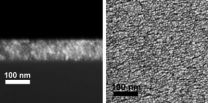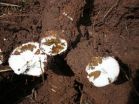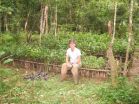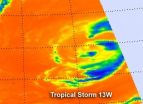(Press-News.org) PROVIDENCE, R.I. [Brown University] — In a touch-screen display or a solar panel, any conductive overlay had better be clear. Engineers employ transparent thin films of indium tin oxide (ITO) for the job, but a high-tech material's properties are only half its resume. They must also be as cheap and easy to manufacture as possible. In a new study, researchers from Brown University and ATMI Inc. report the best-ever transparency and conductivity performance for an ITO made using a chemical solution, which is potentially the facile, low-cost method manufacturers want.
"Our technology is already at the performance level for application in resistive touch screens," said Jonghun Lee, a Brown chemistry graduate student and lead author of the paper posted online Aug. 1 by the Journal of the American Chemical Society.
The group made conductive ITO films 146 billionths of a meter thick that allowed 93 percent of light to pass through, a transparency comparable to the glass plates they were deposited on. The team also made their films on top of bendable polyimide, showing that it could potentially be useful for making flexible display technologies.
In several experiments they showed that by varying the thickness and the tin content (between 5 and 10 percent was best) they could vary the transparency and resistance to find the best combination.
"By controlling the concentration of the nanocrystal solution, we could control the thickness of the film from 30 nanometers to 140 nanometers," Lee said.
The solution
To make the films, the team synthesized nanoscale ITO crystals in a solution. Then they made a flat and smooth film of them by dripping the solution onto a glass plate followed by rapid spinning, a process called spin casting. From there they baked, or annealed, the coated plates for several hours (the best length of time turned out to be six hours) and then tested their transparency and conductivity.
Spin casting is simple as high-tech manufacturing processes go, but finding the chemistry that allows spin casting to produce a high-performance ITO thin film has proven elusive. A key achievement described in the new paper, was finding the materials needed to make the nanoscale ITO crystals in the first place, said Shouheng Sun, professor of chemistry at Brown and the study's corresponding author.
The best chemicals turned out to be indium acetylacetonate and tin bis(acetylacetonate)dichloride. They synthesized ITO nanocrystals that had a narrow range of sizes, about 11 billionths of a meter in diameter. That consistency meant that when the crystals arranged themselves in the thin films, they neither bunched together in clumps, nor stayed too far apart. The result was a dense but evenly distributed array of crystals, which promotes conductivity.
"If the particle clumps, then you cannot get uniform assembly and you can't get good conductivity," Sun said.
This discovery was critical for achieving the high-level performance detailed in the paper, but the team knows it still needs to build on that progress — for instance, to match the conductivity performance of films made by a process called sputtering.
"The next step is to improve conductivity to a magnitude commensurate with sputtered ITO while realizing the reduced cost and process efficiency benefits expected of a solution-based ITO deposition method," said Melissa Petruska, senior scientist at ATMI and co-author of the paper.
In new experiments, therefore, the team plans to further drive down electrical resistance, to reduce the length of time the films need to anneal, and to lay down fine patterns of their films, rather than continuous sheets, using inkjet or roll-to-roll printing.
INFORMATION:
In addition to Sun and Lee, the other Brown authors are Sunghwan Lee, Guanglai Li and David Paine.
ATMI provided project funding and engineering assistance for the research.
Chemists advance clear conductive thin films
Best results yet from ITO nanocrystal solution
2012-08-08
ELSE PRESS RELEASES FROM THIS DATE:
Diseased trees new source of climate gas
2012-08-08
Diseased trees in forests may be a significant new source of methane that causes climate change, according to researchers at the Yale School of Forestry & Environmental Studies in Geophysical Research Letters.
Sixty trees sampled at Yale Myers Forest in northeastern Connecticut contained concentrations of methane that were as high as 80,000 times ambient levels. Normal air concentrations are less than 2 parts per million, but the Yale researchers found average levels of 15,000 parts per million inside trees.
"These are flammable concentrations," said Kristofer Covey, ...
Researchers demonstrate control of devastating cassava virus in Africa
2012-08-08
ST. LOUIS, MO, August 7, 2012— An international research collaboration recently demonstrated progress in protecting cassava against cassava brown streak disease (CBSD), a serious virus disease, in a confined field trial in Uganda using an RNA interference technology. The field trial was planted in November 2010 following approval by the National Biosafety Committee of Uganda. The plants were harvested in November 2011 and results were published in the August 1, 2012 issue of the journal Molecular Plant Pathology . These results point researchers in the right direction ...
GEN reports on recent progress in Alzheimer's research
2012-08-08
New Rochelle, NY, August 7, 2012—The global market value of Alzheimer's disease therapeutics could soar to the $8 billion range once therapeutics are approved that actually change the course of the disease, reports Genetic Engineering & Biotechnology News (GEN). The current therapeutic market is valued at $3 to $4 billion, shared among drugs that temporarily delay disease progression or address the symptoms but do not alter the underlying disease, according to a recent issue of GEN.
"Despite all the research on amyloid plaques and neurofibrillary tangles there is still ...
Notre Dame researcher is shedding light on how jaws evolve
2012-08-08
If you're looking for information on the evolution and function of jaws, University of Notre Dame researcher Matt Ravosa is your man.
His integrative research program investigates major adaptive and morphological transformations in the mammalian musculoskeletal system during development and across higher-level groups. In mammals, the greater diversification and increasingly central role of the chewing complex in food procurement and processing has drawn considerable attention to the biomechanics and evolution of this system. Being among the most highly mineralized, and ...
Can nature parks save biodiversity?
2012-08-08
The 14 years of wildlife studies in and around Madagascar's Ranomafana National Park by Sarah Karpanty, associate professor of wildlife conservation at Virginia Tech's College of Natural Resources and Environment, and her students are summarily part of a paper on biodiversity published July 25 by Nature's Advanced Online Publication and coming out soon in print.
As human activities put increasing pressures on natural systems and wildlife to survive, 200 scientists around the world carved up pieces of the puzzle to present a clearer picture of reality and find ways to mitigate ...
Planting the seeds of defense
2012-08-08
LA JOLLA, CA----It was long thought that methylation, a crucial part of normal organism development, was a static modification of DNA that could not be altered by environmental conditions. New findings by researchers at the Salk Institute for Biological Studies, however, suggest that the DNA of organisms exposed to stress undergo changes in DNA methylation patterns that alter how genes are regulated.
The scientists found that exposure to a pathogenic bacteria caused widespread changes in a plant's epigenetic code, an extra layer of biochemical instructions in DNA that ...
Increasing federal match funds for states boosts enrollment of kids in health-care programs
2012-08-08
Ann Arbor, Mich. — Significantly more children get health insurance coverage after increases in federal matching funds to states for Medicaid and the Children's Health Insurance Program (CHIP), according to new research from the University of Michigan.
The research, published Monday in the journal Health Affairs, showed that a 10-percentage-point increase in the federal match for Medicaid and CHIP, similar to the increase that occurred with the American Reinvestment and Recovery Act, is associated with an increase of 1.9 percent in the number of children enrolled in ...
Infrared NASA imagery shows a weaker Tropical Storm 13W
2012-08-08
Infrared satellite imagery from shows how cold cloud top temperatures are in a tropical cyclone, and recent imagery from NASA's Aqua satellite shows the cloud-top temperatures have been warming in Tropical Storm 13W. Warming cloud top temperatures indicate less strength, and Tropical Storm 13W is weakening.
NASA's Aqua satellite passed over Tropical Storm 13W on August 7 at 0253 UTC. The Atmospheric Infrared Sounder (AIRS) instrument that flies onboard Aqua captured an infrared image of the storm's cloud temperatures that showed very limited strong thunderstorms make ...
NASA sees Tropical Storm Haikui closing in on China
2012-08-08
Tropical Storm Haikui is headed for landfall in southeastern China, and NASA's Aqua satellite caught a stunning image of its size and its ragged, but wide eye when it was a typhoon earlier today, August 7. As a result of interaction with land, Haikui has weakened to a tropical storm.
When NASA's Aqua satellite passed over Typhoon Haikui on August 6, 2012 at 12:35 a.m. EDT the Moderate Resolution Imaging Spectroradiometer (MODIS) instrument onboard captured an image of the storm as it was approaching China. The MODIS image clearly showed Haikui's ragged and elongated eye ...
NASA satellites revealed Tropical Storm Ernesto's strongest side
2012-08-08
Satellite data helps forecasters see where the strongest part of a tropical cyclone is located, and NASA's Aqua satellite noticed Ernesto's strongest storms were on the eastern side yesterday. Today, strong storms surround Ernesto's center.
A visible image of Tropical Storm Ernesto approaching Central America was captured by the Moderate Resolution Imaging Spectroradiometer (MODIS) instrument that flies onboard NASA's Aqua satellite. In an image captured on August 6, 2012 at 1840 UTC (2:40 p.m. EDT), the strongest thunderstorms appeared to be on the northern and eastern ...
LAST 30 PRESS RELEASES:
The Lancet: COVID-19 vaccine hesitancy decreased over time, though mistrust persists among certain groups, study of over 1 million people in England suggests
Psychosis patients ‘living in metaphor’ -- new study radically shifts ideas about delusions
Clinical trial in Ethiopia targets the trachoma scourge
Open-sourcing the future of food
Changes in genetic structure of yeast lead to disease-causing genomic instabilities
UC San Diego Health Sciences Grant Writing Course helps launch successful research careers
Study: Many head and neck cancer trials end early. Why?
Tufts vice provost for research named Foreign Fellow of Indian National Science Academy
New model improves prediction of prostate cancer death risk
Two wrongs make a right: how two damaging variants can restore health
Overlooked decline in grazing livestock brings risks and opportunities
Using rare sugars to address alcoholism
Research alert: New vulnerability identified in aggressive breast cancer
Ruth Harris honored with SSA Distinguished Service Award
Treasure trove of data on aging publicly accessible
Trees4Adapt project to address risks from climate change and biodiversity loss through tree-based solutions
Nature Communications study from the Lundquist Institute identifies molecular mechanism underlying peripartum cardiomyopathy
Pennington Biomedical’s Dr. Gang Hu appointed to NIH Reproductive, Perinatal and Pediatric Health Review Group
World-first project shows great promise to treat low eye pressure
New technique puts rendered fabric in the best light
Brain cancer digital twin predicts treatment outcomes
Cat disease challenges what scientists thought about coronaviruses
Paulson Family Foundation makes an additional $19 million donation to Hebrew University to fund a new building for electrical engineering. Together with its previous gift brings the total donation to
Canada–Estonia partnership advances community-centered clean energy
Sandia’s economic impact sets record for 17th consecutive year
Researchers uncover how tumors become resistant to promising p53-targeted therapy
Aligning games and sets in determining tennis matches
UOC research team develops method to evaluate apps for treating depression
Extreme heat waves disrupt honey bee thermoregulation and threaten colony survival
New brain study explains how binge drinking contributes to long-lasting negative feelings
[Press-News.org] Chemists advance clear conductive thin filmsBest results yet from ITO nanocrystal solution






